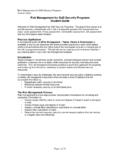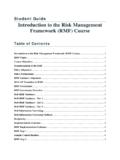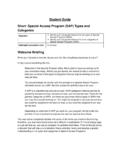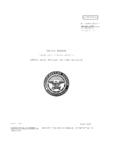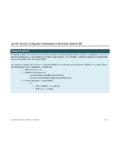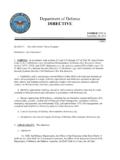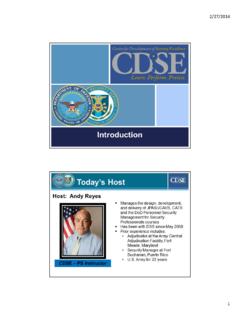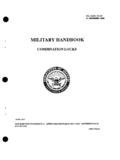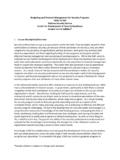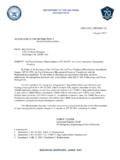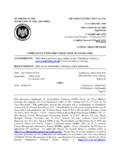Transcription of Student Guide - DoD Initial Orientation and …
1 DoD Initial Orientation and awareness training Student Guide 6/1/2017 1 of 15 Student Guide - DoD Initial Orientation and awareness training Introduction Welcome to the Department of Defense (DoD) Initial Orientation and awareness training ! The purpose of this training is to provide you with the basic security knowledge necessary to recognize threats to our National Security Information and be able to counter those threats in the performance of your responsibilities. Course Objectives By the end of this course, you will be able to: Describe the Personnel Security Clearance Process Understand the Information Security Program and your role in it Describe the Pre-publication process Explain the importance of the Physical Security Program in protecting classified information Recognize the role of Operations Security (OPSEC) Understand the requirements for reporting foreign travel Personnel Security The Personnel Security Program provides security policies and procedures; establishes standards, criteria, and guidelines for personnel security determinations and overall program management responsibilities.
2 Whenever a DoD employee or contractor requires access to classified national security information (information that requires protection against unauthorized disclosure), and its classified status is marked accordingly, the individual must be granted security clearance eligibility at the proper level to access that information. The security clearance process is a tool that helps make sure national security information is not given to people who cannot be trusted. Within the DoD, each position is categorized with respect to security sensitivity. Categories include: Special-sensitive: Requires eligibility for access to Sensitive Compartmented Information (SCI)/Top Secret (TS) or Special Access Program (SAP) level information and has the potential for inestimable damage to National Security. Critical-sensitive: Requires eligibility for access to TS information and has the potential for exceptionally grave damage to National Security. Non critical-sensitive: Requires eligibility for access to Secret or Confidential DoD Initial Orientation and awareness training Student Guide 6/1/2017 2 of 15 level information and has the potential for significant damage to National Security.
3 Non-sensitive: Requires no clearance or other sensitive National Security Duties. The Personnel Security Clearance Process ensures that members of the Armed Forces, DoD civilian employees, DoD contractor personnel, and other affiliated persons are granted access to classified information and/or assignment to a national security sensitive position consistent with the interests of national security. The Personnel Security Clearance Process includes Investigation, Adjudication, Periodic Reinvestigation, and Self-Reporting throughout the process. Investigations The Revised Federal Investigative Standards (FIS), signed in 2012, establishes requirements for conducting Federal background investigations to determine eligibility and will be implemented using a phased approach. The revised FIS utilizes a new five-tiered investigative model. For the purposes of this course, we will only focus on Tier 3 and Tier 5 security background investigations, adjudications, periodic reinvestigations, and self-reporting.
4 The FIS Tier 3 and Tier 5 security background investigations are conducted for national security positions to determine your eligibility for: Access to classified information Acceptance or retention in the Armed Forces Assignment to a designated national security sensitive position Your refusal to complete security documentation may result in the revocation or denial of your eligibility. Adjudications After the investigation is completed, the case is sent to Adjudications to assess the probability of future behavior that could have an adverse effect on National Security. The DoD Consolidated Adjudications Facility (DoD CAF) is the primary authority for making security clearance eligibility determinations for DoD Personnel. Each case is weighed on its own merits utilizing the whole person concept, which looks at all available and reliable information about an individual s past and present prior to reaching an adjudicative determination. Periodic Reinvestigation Under the FIS, there are two types of periodic reinvestigations for national security clearances: Tier 3 R: Required for continued Secret and Confidential clearance eligibility.
5 Tier 3R periodic reinvestigations will continue to be conducted DoD Initial Orientation and awareness training Student Guide 6/1/2017 3 of 15 every ten years. Tier 5 R: Required for continued TS or SCI clearance eligibility. Tier 5 reinvestigations have been extended from five years to six years with DNI endorsement. For more information see the DoD Memorandum Extension of Periodic Reinvestigation Timelines to Address the Background Investigation Backlog . Self-Reporting As part of the Security Clearance process, you must self-report any changes in status, adverse information, and foreign contacts as they occur to the Security Office. Remember, if you don t self-report, someone else might! Reporting does not automatically result in revocation of eligibility so don t be afraid to report! Change in Status Some examples of change in status would be: Marriage/co-habitation, addition of a new family member, divorce, or the receipt of a large sum of cash ( , lottery).
6 Adverse Information Adverse information must also be reported, but what is adverse information? Adverse information is any information that adversely reflects on the integrity or character of a cleared employee, which suggests that his or her ability to safeguard classified information may be impaired or that his or her access to classified information clearly may not be in the interest of National Security. Some examples of adverse information that you must report include: Criminal activity, including domestic violence or issuance of a restraining order, driving under the influence/driving while intoxicated (known as a DUI or DWI) and traffic tickets in excess of $300 Excessive indebtedness or recurring financial difficulties and bankruptcy Use of illegal drugs or misuse of controlled substances Any pattern of security violations or disregard for security regulations Foreign Contacts DoD personnel are required to report any close and continuing association with a foreign national to the Security Office.
7 This also includes DoD Initial Orientation and awareness training Student Guide 6/1/2017 4 of 15 relationships involving financial or personal ties and requests from anyone requesting access to classified or controlled information. Note: Failure to report foreign contacts when required may result in re-evaluation of eligibility for access to classified information. Information Security Now let s take a look at the Information Security Program and the role that you play in the program. Information Security is defined as the system of policies, procedures, and requirements established to protect classified and controlled unclassified information (CUI) that, if subjected to unauthorized disclosure, could reasonably be expected to cause damage to national security. So what is classified information? Classified information is official government information that has been determined to require protection against unauthorized disclosure in the interest of National Security and that has been so identified by being marked.
8 Only individuals with the appropriate clearance eligibility, need-to-know, and signed Standard Form (SF) 312 Classified Information Non-disclosure Agreement may access classified information. All classified documents require a cover sheet. The levels of Classified Information are: Top Secret: If compromised, could cause exceptionally grave damage to national security - use SF 703 as a cover sheet. Secret: If compromised, could cause serious damage to national security - use SF 704 as a cover sheet. Confidential: If compromised, could cause damage to national security - use SF 705 as a cover sheet. We just discussed classified documents. For classified media, such as CDs/DVDs, hard drives, and thumb drives, be sure to use the appropriate medium tags or stickers. Classified medium tags are as follows: SF 706, Top Secret label SF 707, Secret label SF 708, Confidential label Original Classification Original classification is the Initial decision that an item of information could reasonably be expected to cause identifiable or describable damage to the national security if subjected to unauthorized disclosure and requires protection in the interest of national security.
9 Information may be originally classified only by the Secretary of Defense, the DoD Initial Orientation and awareness training Student Guide 6/1/2017 5 of 15 Secretaries of the Military Departments, and other officials to whom they delegate this authority in writing. Delegation of Original Classification Authority (OCA) shall be limited to the minimum number of officials required for effective operation of the DoD. Authority shall be delegated to, and retained by, only those officials who have a demonstrable and continuing need to exercise it. Top Secret, Secret, and Confidential may only be used to mark Executive Branch information that has been properly designated as classified national security information under Executive Order (EO) 13526. Information shall not be classified for any reason unrelated to the protection of national security. Individuals who believe that information in their possession is inappropriately classified or inappropriately unclassified must bring their concerns to the attention of the Office of Security.
10 Your agency may or may not have Original Classification Authority. Please note that additional training is required for OCAs. Refer to DoDM for more information. Derivative Classification Derivative classification is defined as incorporating, paraphrasing, restating, or generating in new form information that is already classified and marking the newly developed material consistent with the classification markings that apply to the source information. Only individuals with the appropriate security clearance, need-to-know, who access classified information as part of their official duties, and are properly trained, may derivatively classify information. Banner lines are at the top and bottom of the document and provide the overall classification markings as well as the dissemination control markings. Portion markings denote the classification for each paragraph, sub-paragraph, or section in the document. In the bottom left is the Classification Authority Block which includes the name and title of the classifier, the source document that the document was derived from, and the declassification date.
